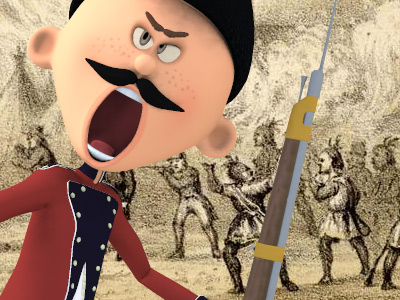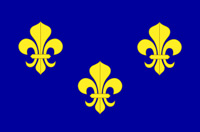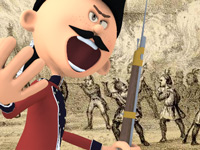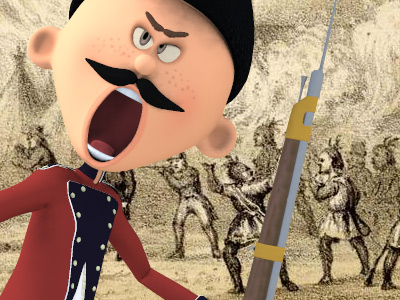Queen Anne's War (1702–1713)

Technology and Organization
Military technology used in North America was not as developed as it was in Europe. Only a few colonial settlements had stone fortifications (among them St. Augustine, Boston, Quebec, and St. John's) at the start of the war, although Port Royal's fortifications were completed early in the war. Some frontier villages were protected by wooden palisades, but many had little more than fortified wooden houses with gun ports through which defenders could fire, and overhanging second floors from which they might fire down on attackers trying to break in below. Europeans were typically armed with smooth-bore muskets that had a maximum range of about 100 yards (91 m), but were inaccurate at ranges beyond half that distance. Some colonists also carried pikes, while tribal warriors were either supplied with European arms, or were armed with more primitive weapons like tomahawks and bows and arrows. A small number of colonists had training in the operation of cannon and other types of artillery; these were the only effective weapons for attacking significant stone or wooden defenses.
English colonists were generally organized into militia companies, and their colonies had no regular military presence beyond a small number in some of the communities of Newfoundland. The French colonists were also organized into militias, but they also had a standing defense force called the troupes de la marine. This force consisted of some experienced officers, and was manned by recruits sent over from France The Kingdom of France is the historiographical name or umbrella term given to various political entities of France in the medieval and early modern period. It was one of the most powerful states in Europe since the High Middle Ages. It was also an early colonial power, with possessions around the world. Colonial conflicts with Great Britain led to the loss of much of its North American holdings by 1763. The Kingdom of France adopted a written constitution in 1791, but the Kingdom was abolished a year later and replaced with the First French Republic.. Numbering between 500 and 1,200, they were spread throughout the territories of New France
The Kingdom of France is the historiographical name or umbrella term given to various political entities of France in the medieval and early modern period. It was one of the most powerful states in Europe since the High Middle Ages. It was also an early colonial power, with possessions around the world. Colonial conflicts with Great Britain led to the loss of much of its North American holdings by 1763. The Kingdom of France adopted a written constitution in 1791, but the Kingdom was abolished a year later and replaced with the First French Republic.. Numbering between 500 and 1,200, they were spread throughout the territories of New France New France was the territory colonized by France in North America, beginning with the exploration of the Gulf of Saint Lawrence by Jacques Cartier in 1534 and ending with the cession of New France to Great Britain and Spain in 1763 under the Treaty of Paris. In the 16th century, the lands were used primarily to draw from the wealth of natural resources such as furs through trade with the various indigenous peoples. In the seventeenth century, successful settlements began in Acadia and in Quebec., with concentrations in the major population centers. Spanish Florida was defended by a few hundred regular troops; Spanish policy was to pacify the natives in their territory and not to provide them with weapons. This policy had devastating consequences: before the war, Florida held an estimated 8,000 natives, but this was reduced to 200 after English
New France was the territory colonized by France in North America, beginning with the exploration of the Gulf of Saint Lawrence by Jacques Cartier in 1534 and ending with the cession of New France to Great Britain and Spain in 1763 under the Treaty of Paris. In the 16th century, the lands were used primarily to draw from the wealth of natural resources such as furs through trade with the various indigenous peoples. In the seventeenth century, successful settlements began in Acadia and in Quebec., with concentrations in the major population centers. Spanish Florida was defended by a few hundred regular troops; Spanish policy was to pacify the natives in their territory and not to provide them with weapons. This policy had devastating consequences: before the war, Florida held an estimated 8,000 natives, but this was reduced to 200 after English The Kingdom of England was a sovereign state on the island of Great Britain from about 927, when it emerged from various Anglo-Saxon kingdoms, until 1 May 1707, when it united with Scotland to form the Kingdom of Great Britain. The Viking invasions of the 9th century upset the balance of power between the English kingdoms, and native Anglo-Saxon life in general. The English lands were unified in the 10th century in a reconquest completed by King Æthelstan in 927. raids made early in the war.
The Kingdom of England was a sovereign state on the island of Great Britain from about 927, when it emerged from various Anglo-Saxon kingdoms, until 1 May 1707, when it united with Scotland to form the Kingdom of Great Britain. The Viking invasions of the 9th century upset the balance of power between the English kingdoms, and native Anglo-Saxon life in general. The English lands were unified in the 10th century in a reconquest completed by King Æthelstan in 927. raids made early in the war.
HISTORY

RESOURCES
This article uses material from the Wikipedia article "Queen Anne's War", which is released under the Creative Commons Attribution-Share-Alike License 3.0.
© Stories Preschool. All Rights Reserved.









